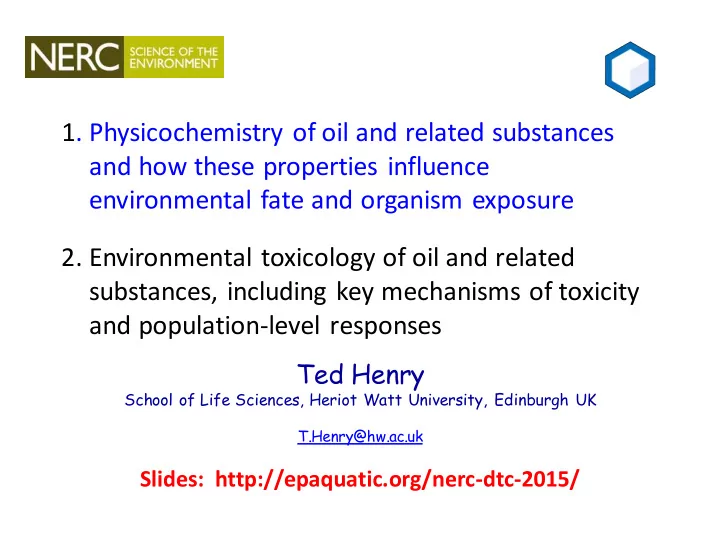

1. Physicochemistry of oil and related substances and how these properties influence environmental fate and organism exposure 2. Environmental toxicology of oil and related substances, including key mechanisms of toxicity and population-level responses Ted Henry School of Life Sciences, Heriot Watt University, Edinburgh UK T.Henry@hw.ac.uk Slides: http://epaquatic.org/nerc-dtc-2015/
What is Oil? • Some terminology – Oil: – Petroleum: – Organic substance: – Hydrocarbon: – Crude oil:
What is Oil? • Some terminology – Oil: any neutral, nonpolar viscous liquid that is hydrophobic and lipophilic (may be animal, vegetable, or petrochemical in origin) – Petroleum: a mixture of naturally occurring substances including hydrocarbons and other organic compounds – Organic substance: most substances containing carbon, almost all substances that contain C-H or C-C bond – Hydrocarbon: a compound consisting entirely of hydrogen and carbon – Crude oil: the term “petroleum” includes unprocessed crude oil and products made from refined crude oil
But remember, release of oil is also a natural process
But remember, release of oil is also a natural process Santa Barbara, CA Natural Oil Seeps account for >60% of annual releases of oil to marine environments
Boiling points of some crude oil constituents Alkanes, cycloalkanes, alkenes Branched/straight chain, aromatics 8-21 carbon atoms
Crude Oil • Complex mixtures - weathering – Alkanes – Cycloalkanes – Naphtheno-aromatics – Aromatics (mono – poly) – Sulfur-, nitrogen-, oxygen-ated organics – Metallo-porphyrins – Asphaltenes
Physicochemical Properties Particular to individual substances and describe their physical form and behaviour and in different media • Molecular weight (g/mol) • Aqueous solubility (mg/L) • Vapour pressure (press. of gas (mm Hg) in eq with liq) • Henry’s Law Constant (diss. gas related to partial press. • Octanol-water partition coefficient (K ow ) • Boiling point (temp: sat. vap. press. = atm. press.)
• Clathrate is a term used to describe the structural organization of “host” molecules around a “guest” molecule. • Hydrogen bonds hold the water molecules together to surround a hydrophobic contaminant
Air 90 Benzene Evaluative triangle Relative partitioning of substances among different compartments 50 10 10 50 50 Phenol 2,3,7,8-TCDD 10 90 90 Water Octanol
PAHs Poly-aromatic hydrocarbons Log K ow MW WS VP • Naphthalene (2) 128.17 31.0 36.81 3.37 • Phenanthrene (3) 178.23 1.1 0.113 4.57 • Pyrene (4) 202.26 0.13 0.012 5.18 • Benzo(a)pyrene (5) 252.32 2.1E -5 0.0038 6.04 • Coronene (7) 2.0E -10 300.36 0.00014 6.75
• Bioavailability • Bioconcentration • Bioaccumulation – Uptake, depuration: factors and figures • Biomagnification
1. Physicochemistry of oil and related substances and how these properties influence environmental fate and organism exposure 2. Environmental toxicology of oil and related substances, including key mechanisms of toxicity and population-level responses Ted Henry School of Life Sciences, Heriot Watt University, Edinburgh UK T.Henry@hw.ac.uk epaquatic.org
ADME • A bsorption: routes, barriers, • D istribution: carrier proteins etc. tissue types • M etabolism: tissues, hydrophobic-hydrophilic • E xcretion: renal, biliary
AhR-Mediated Toxicity ARNT AhR AhR PAH Cyp1A other Detoxification PAH PAH-OH mRNA Cyp1A Cyp1A Toxic Other responses proteins
Hicken et al., 2011 • Introduction (topic sentences of each paragraph) – “Oil spills such as the 1989 Exxon Valdez spill and the 2010 Deep Water Horizon disaster pose major threats to fish health and population vitality.” – “Because of logistical difficulties of identifying mechanisms of toxicity in wild species, we use the zebrafish ( Danio rerio ) model to explore the long-term impacts of sub-lethal oil exposure” – “We hypothesized that low levels of embryonic oil exposure might influence ventricular shape, and, ultimately, cardiac output in adult animals because previous studies showed that intermediate PAH concentrations caused a compensatory dilation of the cardiac chambers in larvae”
Hicken et al., 2011 • Methods – ZF embryos exposed (48 h) to weathered crude oil – Cyp1A activity measured – Adult fish swimming performance assay – Histology of heart
Hicken et al., 2011 Results
AhR-Mediated Toxicity ARNT AhR AhR PAH Cyp1A other Detoxification PAH PAH-OH mRNA Cyp1A Cyp1A Toxic Other responses proteins
Wirgin et al., 2011
Wirgin et al., 2011 • “Our results indicate that recent evolution has occurred in the population as a results of selective pressures. The bioaccumulation of high levels of persistent HAHs, minimal gene flow with populations in nearby estuaries , and strong selective pressure lead us to conclude that HR tomcod have experienced rapid evolutionary change in the 50-100 years since the release of these contaminants”
Recommend
More recommend